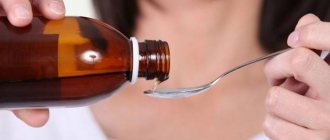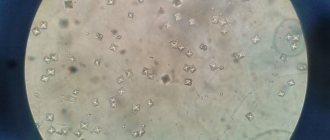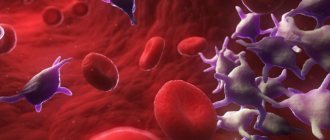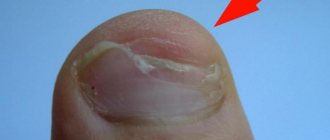A difficult pregnancy, as well as a protracted labor, during which the newborn experienced hypoxia, can cause disturbances in the functioning of his brain. They manifest themselves in increased intracranial or ocular pressure, and increased production of cerebrospinal fluid.
To help him cope with this problem, it is necessary to contact a neurologist. Depending on the disease and its stage, as well as the age of the baby, he will select the appropriate treatment for him.
Diacarb is often prescribed for infants to improve brain function. This is a diuretic drug, thanks to which excess fluid is quickly removed from the body. Asparkam is usually prescribed together with it, since the first medication flushes out not only water, but also potassium from the baby’s body, and the second one compensates for its deficiency.
A child who has this disease constantly cries, practically does not sleep, and periodically arches. It is not easy to calm him down, because the baby is not tormented by hunger and thirst, but by severe pain in his small head
Compound
The main active ingredient is acetazolamide. The tablet alone contains 250 mg of it. Additional substances may include microcrystalline cellulose, as well as povidone, primellose and colloidal silicon dioxide. In addition, it contains magnesium stearate.
The medicine may also contain other substances. For example, sodium starch glycolate together with talc, as well as potato starch.
Both one and the other version of the drug composition are absolutely safe for newborns. They both have the same effect on the body. It is necessary to know what components are contained in Diakarb so that if an allergic reaction occurs, you can understand what caused it. If both of these drugs do not work, it means that the child has an intolerance to the active substance. If one baby perceives it normally, but the other does not, then to identify the allergen it is necessary to start from the composition of the medicine that caused the reaction in him.
Instructions for use of Diacarb (Method and dosage)
For those who have been prescribed Diacarb tablets, the instructions for use inform that the dosage regimen may vary depending on the disease, the characteristics of the body and the age of the patient.
In case of edematous syndrome, the initial daily dosage is 250-375 mg. You need to take the product once a day. The maximum diuretic effect occurs after 1-2 days of administration. Then it is advisable to take a break for 24 hours. When taking the medicine, the instructions for use of Diakarb advise simultaneously treating circulatory failure, replenishing potassium levels and following a diet limited in salt intake.
For open-angle glaucoma, the medicine is taken several times a day. Dose – 250 mg. In case of secondary glaucoma, 250 mg is prescribed every 4 hours. Children are prescribed 10-15 mg per 1 kg of body weight per day. The daily dosage must be divided into several doses.
Tablets at a dosage of 500-1000 mg/day are recommended to be taken 1-2 days before climbing the mountain. If symptoms of mountain sickness still appear, it is necessary to continue therapy for two days.
For epilepsy, adult patients are given 250-500 mg of medication per day. The course lasts 3 days. Then you need to take a break. In turn, the instructions for use of Diakarb for children provide the following daily dosages depending on age:
- 4-12 months – 50 mg;
- 2-3 years – 50-125 mg;
- 4-18 years – 125-500 mg.
When combined with anticonvulsants , the initial daily dosage is 250 mg. If required, it can be increased. But children should not take a daily dose exceeding 750 mg.
For any indication, if a dose is missed, the next dose cannot be increased.
Therapeutic effects
Diacarb has the following effects on the newborn’s body:
- antiglaucoma;
- diuretic;
- reduction of intracranial pressure;
- antiepileptic.
With prolonged use of the medicine, the diuretic effect disappears. For this reason, the course of therapy is carried out with short breaks. For example, a newborn uses medication for 3-4 days, and then not for 2-3 days.
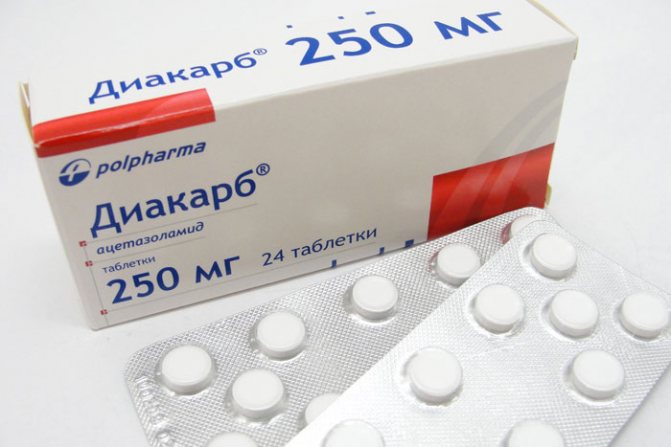
Before using the medicine, you must read the instructions for use
Indications for use
Indications for use of the product are:
- Increased intracranial pressure.
- Swelling.
- Meniere's disease.
- Circulatory failure.
- Glaucoma.
- Pulmonary vascular syndrome.
- Epilepsy.
- Gout.
- Emphysema.
- Bronchial asthma.
This product can be used from 6 months. If the child is younger, you should consult your doctor before taking the medicine.
Who should take the medicine?
Despite the fact that Diacorb is one of the best medicines that helps eliminate brain disorders, it cannot be used by everyone.
We recommend reading: Hydrocephalic syndrome in infants
Thus, the instructions for the medication state that its use is prohibited for newborns with pathologies such as:
- metabolic acidosis;
- liver cirrhosis or diabetes mellitus;
- adrenal or renal or liver failure;
- hyponatremia or hypokalemia;
- Addison's disease or uremia;
- urolithiasis accompanied by hypercalciuria;
- chronic angle-closure glaucoma.
Komarovsky about intracranial pressure

Komarovsky is skeptical about diseases that are based on increased intracranial pressure. The doctor says that intracranial pressure can only be measured through a spinal tap test or during appropriate brain surgery.
Komarovsky believes that justified reasons for treatment with diacarb are congenital hydrocephalus (in which the child’s head size increases, the fontanelle does not gradually heal, but rather enlarges and becomes convex, the spaces between the sutures of the skull expand), meningitis, encephalitis, surgical interventions after birth or acquired injuries.
The doctor pays special attention to the fact that intracranial pressure in newborns can be treated with medication during the first two months. If the therapy does not help, the medication is discontinued and replaced with physiotherapy, massages and other procedures.
Komarovsky also blames the fact that modern pediatricians and neurologists often make diagnoses related to intracranial pressure without any basis. Hyperactivity, poor sleep, veins on the head, trembling chin - these symptoms are not signs of high intracranial pressure, so taking medications to treat a non-existent disease is not justified. The regimen of diacarb and asparkam should be used exclusively for confirmed diagnoses.
Side effects
There are many of them, and if a child has already been prescribed medication, then parents should be aware of the possibility of their occurrence.
| Blood system | Myelophthisis and aplastic anemia, pancytopenia and leukopenia, thrombocytopenia and agranulocytosis, hemorrhagic diathesis. |
| Nervous system | Hepatic encephalopathy, confusion and paresthesia, tinnitus, as well as photophobia, impairment of hearing or touch, dizziness, convulsions and ataxia, and fatigue. |
| Allergy | Skin redness and itching, Lyell's syndrome and Stevens-Johnson disease, urticaria and anaphylactic shock. |
| Digestive system | Fulminant liver necrosis, nausea and diarrhea, impaired taste or appetite, hepatic colic and vomiting. |
| Analysis indicators | Glucosuria or hyponatremia, hematuria, metabolic acidosis or hypokalemia. |
| Urinary system | Frequent trips to the toilet “in small ways”, the appearance of kidney stones. |
| Other | Muscle aches, high fever. |
Diakarb for newborns
Children under one year of age can be prescribed this drug for epilepsy . In addition, Diakarb for newborns is used for excessive enlargement or divergence of the sutures of the skull. It helps reduce the amount of cerebrospinal fluid.
For newborns, this remedy is prescribed by a doctor. Taking Diacarb requires careful supervision by a specialist.
The best option is to monitor the baby in a hospital setting throughout the course. However, this drug is often given at home. In this case, the specialist is obliged to warn parents about possible adverse reactions and specify the exact timing of admission (no more than 5 days). Upon completion of the course, you must take the appropriate tests again.
How to use the drug correctly
Only a neurologist can prescribe Diakarb to a newborn. Under no circumstances should you treat a child with this medicine without consulting him. How to give and in what quantities should also be decided by the doctor. Dosage may depend on many factors that parents may not consider.
The medication regimen may be as follows:
- Once every three days, give the baby a quarter of a tablet per day.
- Use the drug one fourth of the tablet for two days, take a break for the other two days.
Attention! Asparkam should be used together with Diacarb. Its dose can be either a quarter of a tablet once a day, or the same amount, but three times a day. Sometimes it may be given intravenously.
It is recommended to give the drug to the baby early in the morning, since it is at this time that intracranial pressure increases. You need to crush part of the tablet and mix it in a spoon with water. Since the medicine has an unpleasant taste, you should offer the baby breast or formula immediately after it.
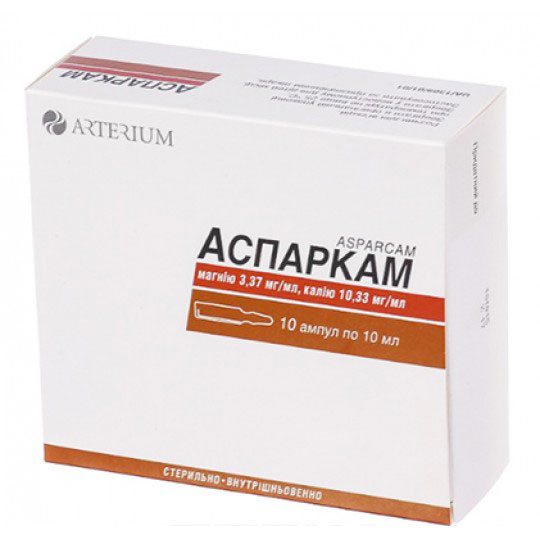
The use of Asparam when using Diacarb is mandatory
special instructions
Interaction with other drugs is possible. Can be taken together with Diacarb Asparkam. Other drugs must be discussed with a specialist before taking because of the likelihood of side effects.
Store the product in a cool, dark place. You cannot increase the dosage yourself; only a doctor can do this. The medicine is available in the form of tablets, so before taking they are crushed and mixed with water.
If the child is under 6 months old, the medicine is given to him only after consultation with a doctor. It is possible that the child will be prescribed a different drug at an earlier age due to the likelihood of side effects.
Reviews
Reviews for Diakarb are quite contradictory. Some mothers praise the drug, write in blogs about how well it helped their babies, that after it they began to sleep better and more peacefully, and finally began to smile at them. Others, on the contrary, scold.
Ksenia Diakarb was prescribed after intracranial pressure was diagnosed in a premature baby at 1 month. We doubted for a long time whether to give it or not; we visited several doctors. On the other hand, we heard a lot of scary stories about what happens to children if ICP is not treated before the age of 1 year, so it was decided to take the drug carefully under the supervision of a doctor according to a gentle regimen. There is an effect from the treatment, but there were also side effects such as shortness of breath, tremors, and blue hands. At the end of the course, the side effects went away.
Maria Diakarb is a serious medicine, but very effective. My child was able to develop normally only thanks to this drug. The main thing is to find a good neurologist who can choose the right dosage, so if in doubt, it is better to go to several specialists. It is important to complete the course of treatment on time - up to 1 year! The sooner you start, the better the result.
Diacarb is a good medicine, but many parents are afraid to use it because of the large number of side effects. In such a situation, we can only advise them to see another doctor who specializes in the disease of their infant. If he prescribes him the same drug and in the same dosage as the first one, then he can safely use it. However, the condition of the baby while taking the medicine still needs to be carefully monitored. If there are any changes in his behavior or well-being, you should report this to your doctor.
Diakarb
Acetazolamide is a carbonic anhydrase inhibitor with weak diuretic activity. The mechanism of action is associated with inhibition of the release of sodium and hydrogen ions in the carbonic acid molecule. Inhibition of carbonic anhydrase activity by acetazolamide suppresses the synthesis of carbonic acid in the proximal tubule of the nephron. The lack of carbonic acid, which is a source of hydrogen ions needed to be replaced by sodium ions, increases the excretion of sodium and water by the kidneys. As a result of the release of large amounts of sodium in the distal part of the nephron, caused by acetazolamide, the replacement of sodium ions with potassium ions increases, which leads to large losses of potassium and the development of hypokalemia. Acetazolamide increases the excretion of bicarbonates, which can lead to the development of metabolic acidosis. Acetazolamide causes the kidneys to excrete phosphates, magnesium, and calcium, which can also lead to metabolic disorders.
After 3 days from the start of use, acetazolamide loses its diuretic properties. After a break in treatment for several days, newly prescribed acetazolamide resumes its diuretic effect due to the restoration of normal carbonic anhydrase activity.
Acetazolamide is used to treat glaucoma. Inhibition of carbonic anhydrase of the ciliary body reduces the secretion of aqueous humor in the anterior chamber of the eye, which reduces intraocular pressure.
Tolerance to this effect does not develop. Iphthalmotonus when taking acetazolamide begins to decrease after 40-60 minutes, the maximum effect is observed after 3-5 hours, intraocular pressure remains below the initial level for 6-12 hours. On average, intraocular pressure decreases by 40-60% from the initial level.
The drug is used as an adjuvant in the treatment of epilepsy, because inhibition of carbonic anhydrase in nerve cells of the brain inhibits pathological excitability.
Acetazolamide is used to treat CSF leaks and intracranial hypertension. The drug suppresses the activity of carbonic anhydrase in the brain, in particular in the choroid plexus of the ventricles, with a decrease in the production of cerebrospinal fluid.
Pharmacokinetics
Acetazolamide is well absorbed from the gastrointestinal tract. After oral administration at a dose of 500 mg, the maximum concentration (12-27 mcg/ml) is reached within 1-3 hours. In minimal concentrations it is retained in the blood for 24 hours from the moment of administration. Acetazolamide is distributed in red blood cells, blood plasma and kidneys, and to a lesser extent in the liver, muscles, eyeball and central nervous system. Acetazolamide crosses the placental barrier and is excreted in small amounts in breast milk. Does not accumulate in tissues and is not metabolized in the body. It is excreted unchanged by the kidneys. After oral administration, about 90% of the dose taken is excreted by the kidneys within 24 hours.

